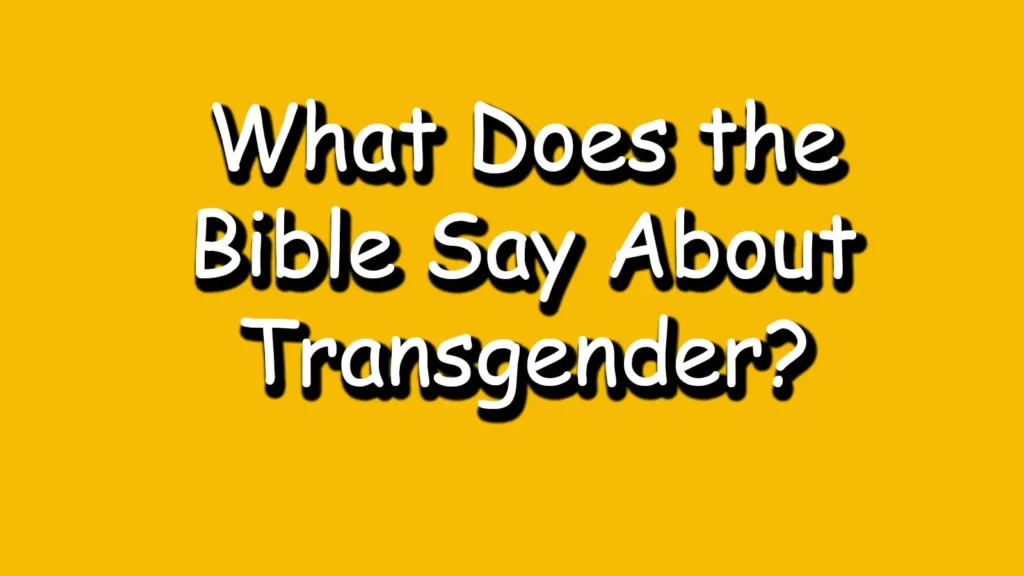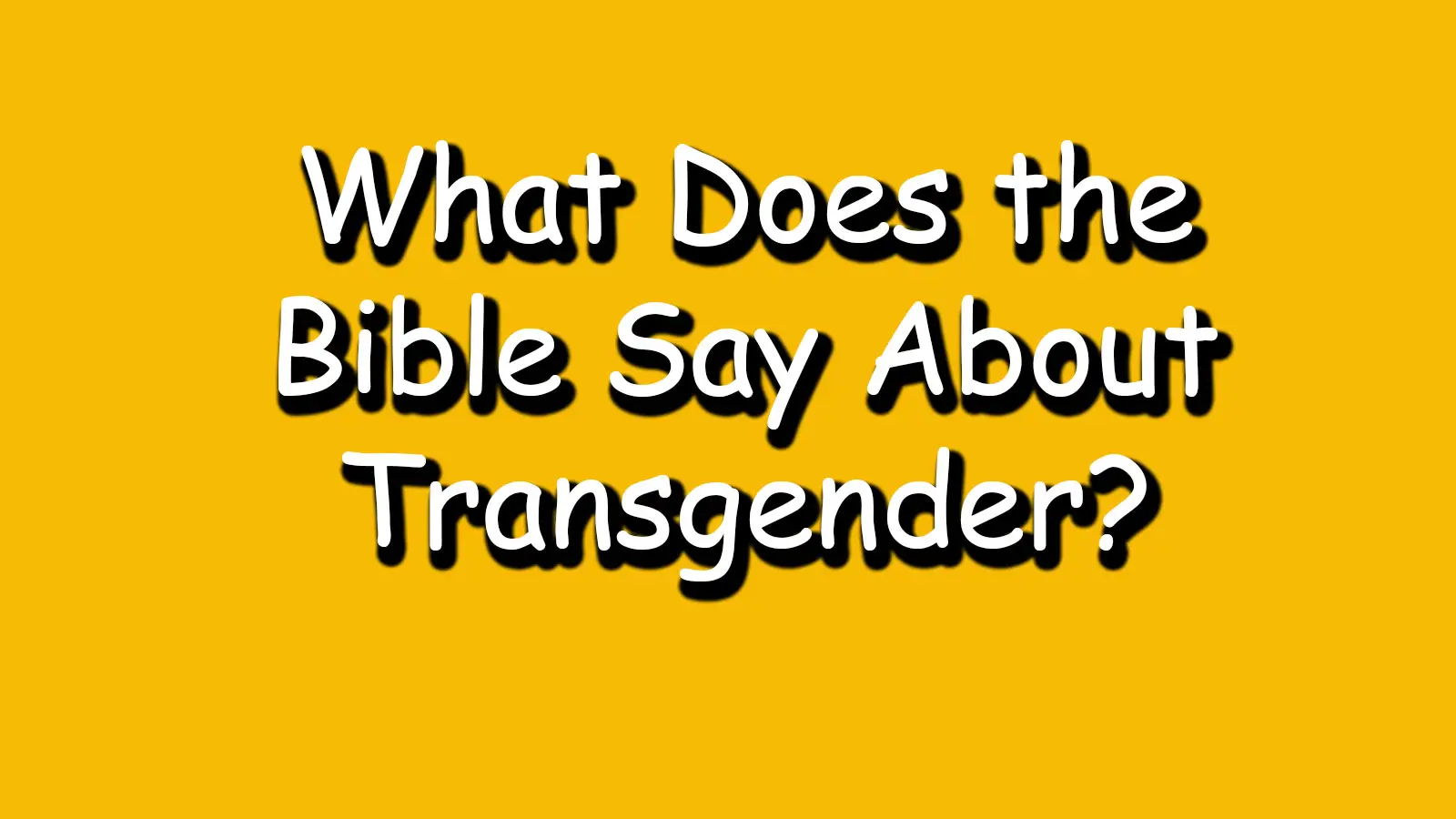The Bible does not have specific verses that address transgender identities, but there are some passages that can be interpreted as supportive of gender diversity. Some Christians believe that the Bible affirms the full inclusion of transgender and non-binary people in the Christian community[1]. Here are some Bible verses that are often cited in support of transgender identities:
– Psalm 139:13-14″For you created my inmost being; you knit me together in my mother’s womb. I praise you because I am fearfully and wonderfully made; your works are wonderful, I know that full well.” This verse is often interpreted as affirming the idea that God creates each person uniquely and intentionally, including their gender identity[2].
– Isaiah 56:4-5: “For this is what the Lord says: ‘To the eunuchs who keep my Sabbaths, who choose what pleases me and hold fast to my covenant—to them I will give within my temple and its walls a memorial and a name better than sons and daughters; I will give them an everlasting name that will endure forever.'” Eunuchs were often considered to be outside of traditional gender roles in biblical times, and this passage suggests that they are still valued and accepted by God[2].
– Galatians 3:28: “There is neither Jew nor Gentile, neither slave nor free, nor is there male and female, for you are all one in Christ Jesus.” This verse is often interpreted as affirming the idea that all people are equal in the eyes of God, regardless of their gender identity[5].
It’s important to note that there are also Christians who interpret the Bible as being opposed to transgender identities. However, many Christians believe that the Bible’s message of love and acceptance applies to all people, including those who are transgender[1].
Citations:
[1] https://www.hrc.org/resources/what-does-the-bible-say-about-transgender-people
[2] https://freecomchurch.org/resources/transgender/biblical-support-for-transgender-identities/
[3] https://www.thegospelcoalition.org/blogs/kevin-deyoung/what-does-the-bible-say-about-transgenderism/
[4] https://www.knowingjesusministries.co/articles/what-does-the-bible-say-about-transgenderism/
[5] https://www.bibleandhomosexuality.org/what-does-the-bible-say-about-transgender-people/
[6] https://www.washingtonpost.com/news/acts-of-faith/wp/2016/08/26/where-in-the-bible-does-it-say-you-cant-be-transgender-nowhere/
In today’s society, conversations surrounding gender identity and transgender individuals have become increasingly prevalent. People are seeking answers, guidance, and understanding from various sources, including religious texts such as the Bible. As an ancient text revered by millions, the Bible holds significant influence in shaping beliefs and perspectives on a wide range of topics. Therefore, it is essential to explore what the Bible says about transgender individuals, their experiences, and their place within the Christian faith.
At its core, the Bible serves as a guide for moral and spiritual teachings, providing insights into the nature of humanity and the relationship between individuals and God. While the Bible does not explicitly address the concept of transgender identity as understood today, it does offer insights into human nature, sexuality, and the importance of compassion and empathy. By examining the biblical perspectives on gender and applying them to the topic of transgender identity, we can gain a deeper understanding of how the Bible can inform our understanding of this complex issue.
Read More: What does Bible Say about Enuchs and LGBTQ+

This article aims to navigate the biblical perspectives on transgender individuals, exploring both the Old Testament and New Testament references, and examining the interpretative debates that arise from them. Additionally, we will delve into the importance of interpreting scripture within its historical and cultural context, separating literal interpretations from contextual ones. By doing so, we can better grasp the underlying principles that guide Christian responses to transgender individuals.
It is crucial to approach this topic with an open mind and heart, embracing a spirit of compassion and understanding. This article seeks to encourage dialogue and foster an atmosphere of empathy and inclusion, aiming to bridge the gap between biblical teachings and the experiences of transgender individuals. Together, let us embark on this journey, examining the biblical perspectives on transgender identity, and striving to create a more inclusive and compassionate world.
Understanding Gender Identity
In order to explore the topic of transgender from a biblical perspective, it is crucial to first understand the concept of gender identity. This section will define transgender, differentiate between sex and gender, and acknowledge the complexity of gender identity.
Defining Transgender
Transgender is an umbrella term used to describe individuals whose gender identity does not align with the sex they were assigned at birth. While assigned sex is based on physical characteristics such as genitalia, gender identity is an individual’s deeply held sense of being male, female, or something else entirely. Transgender individuals may identify as the gender opposite to their assigned sex or as a non-binary or genderqueer person who does not conform to traditional gender categories.
Differentiating Between Sex and Gender
It is important to differentiate between sex and gender, as they are often mistakenly used interchangeably. Sex refers to the biological and physiological characteristics that distinguish males from females. These include reproductive organs, chromosomes, and hormones. Gender, on the other hand, is a social and cultural construct that encompasses the roles, behaviors, activities, and expectations society assigns to individuals based on their perceived sex. While sex is typically binary (male or female), gender exists on a spectrum, allowing for a wide range of identities beyond the binary.
Acknowledging the Complexity of Gender Identity
Gender identity is a deeply personal and complex aspect of an individual’s identity. It is influenced by a variety of factors, including biology, genetics, psychology, and culture. Understanding and respecting the diversity of gender identities is crucial in creating a more inclusive and affirming society. It is important to recognize that gender identity is not a choice or a phase but a fundamental aspect of a person’s being.
By exploring and understanding the complexities of gender identity, we can approach the biblical perspectives on transgender with greater empathy and insight. It is through this understanding that we can engage in meaningful dialogue and foster a more inclusive and compassionate society.
Historical and Cultural Context
In order to fully understand the biblical perspectives on transgender, it is essential to consider the historical and cultural context of the time in which the Bible was written. By delving into the societal norms and gender roles prevalent during biblical times, we can gain valuable insights into how these perspectives on gender identity were shaped.
Considering biblical times and societal norms
During biblical times, gender roles were deeply entrenched in society. The roles and expectations assigned to men and women were largely based on traditional and patriarchal beliefs. Men were typically considered the primary providers and decision-makers, while women were expected to fulfill domestic duties and bear children. These gender roles were not only prevalent in the Hebrew culture but were also observed in various ancient civilizations.
It is important to note that the understanding of gender and sexuality in ancient times differed significantly from our modern understanding. The concept of gender as a spectrum was not widely acknowledged, and any deviation from the traditional binary understanding of male and female was met with skepticism and often condemned.
Examining gender roles in the Bible
When examining the Bible, it becomes evident that it reflects the gender norms and roles prevalent during the time of its writing. Many passages reinforce the traditional patriarchal structure, with men being portrayed as leaders and women as submissive and subordinate. For example, in Ephesians 5:22-24, it states, “Wives, submit yourselves to your own husbands as you do to the Lord. For the husband is the head of the wife as Christ is the head of the church.”
However, it is crucial to approach these passages with a nuanced understanding. The Bible is a diverse collection of texts spanning different genres, written by various authors over centuries. The cultural context in which these passages were written must be taken into account to fully grasp their intended meaning.
Moreover, there are instances in the Bible where women play significant roles and display agency and leadership. Examples include Deborah, who served as a judge in Israel (Judges 4:4-5), and Phoebe, who is referred to as a deacon in the early Christian community (Romans 16:1-2). These examples challenge the notion that women were solely confined to submissive roles.
By examining the historical and cultural context, we can gain a more comprehensive understanding of the biblical perspectives on gender. This understanding will enable us to approach the topic of transgender from a place of knowledge and empathy, seeking to bridge the gap between ancient beliefs and our modern understanding of gender identity.
Biblical Perspectives on Gender
The Bible, as a collection of ancient texts, offers insights into various aspects of human existence, including the concept of gender. To explore biblical perspectives on gender, it is important to examine both the Old Testament and New Testament references, as well as the interpretations and debates that have arisen from them.
Old Testament References
In the Old Testament, there are several passages that touch on the topic of gender. For instance, in Genesis 1:27, it is written: “So God created mankind in his own image, in the image of God he created them; male and female he created them.” This verse establishes the foundational understanding of gender as a binary concept, with the creation of both male and female.
Other passages, such as Deuteronomy 22:5, address the issue of cross-dressing: “A woman must not wear men’s clothing, nor a man wear women’s clothing, for the LORD your God detests anyone who does this.” These verses have been used to argue against transgender individuals expressing their gender identity.
New Testament References
In the New Testament, the teachings of Jesus Christ and the writings of the apostles provide additional insights into gender. While the topic of transgender is not directly addressed, passages such as Galatians 3:28 emphasize the equality of all believers: “There is neither Jew nor Gentile, neither slave nor free, nor is there male and female, for you are all one in Christ Jesus.”
This verse has been interpreted to highlight the spiritual equality of all individuals, regardless of their gender. However, it is essential to note that interpretations can vary among different Christian denominations and scholars.
Interpretations and Debates
The interpretation of biblical passages related to gender is a topic of ongoing debate among theologians, scholars, and believers. Some interpret the Bible’s teachings on gender as strictly binary, affirming that God’s intention is for individuals to identify exclusively as male or female.
On the other hand, there are those who argue for a more inclusive understanding of gender, suggesting that the Bible allows for a broader spectrum of gender identities. They propose that the cultural and historical context of biblical times should be considered when interpreting these passages.
It is important to approach these debates with an open mind and a willingness to engage in respectful dialogue. Christians may find themselves grappling with the tension between upholding the authority of Scripture and showing compassion towards transgender individuals.
To gain a deeper understanding of these perspectives, it is valuable to consult a variety of sources, engage in thoughtful conversations, and seek guidance from knowledgeable and compassionate individuals within the Christian community.
By exploring the Old Testament and New Testament references, as well as considering the interpretations and debates surrounding gender in the Bible, we can foster a more nuanced and compassionate understanding of transgender individuals within a biblical context.
Interpreting Scripture on Transgender
When it comes to interpreting scripture on transgender, there are various approaches that can be taken. One of the key considerations is the literal versus contextual interpretation of the biblical text. While some individuals adhere strictly to a literal interpretation, others believe that understanding the cultural and historical context is crucial in interpreting the Bible.
Taking a literal interpretation means reading the text exactly as it is written, without considering the broader context or cultural nuances. However, it is important to recognize that the Bible was written in a specific time and place, and the language used reflects the cultural norms of that time. Therefore, a contextual interpretation takes into account the historical and cultural context in which the text was written.
By considering the cultural and historical context, we can gain a deeper understanding of the biblical perspectives on gender. In biblical times, the concept of gender was often closely tied to biological sex, and there were specific societal expectations and roles assigned to men and women. These gender roles are reflected in various passages of the Bible, which can provide insights into the biblical understanding of gender.
However, it is important to note that the Bible is a complex and multifaceted text, and there is no single, definitive interpretation of its teachings on gender. Different scholars and theologians may have varying interpretations and understandings of the underlying principles. This can lead to interpretations and debates surrounding the biblical perspectives on transgender.
To truly understand the biblical teachings on transgender, it is essential to approach the text with an open mind and a willingness to explore different perspectives. This involves considering both the literal words of the text and the broader cultural and historical context in which it was written. By doing so, we can gain a more nuanced understanding of the underlying principles that can guide our understanding of gender and transgender issues.
In the next section, we will explore the Christian responses to transgender individuals, which can shed further light on how the biblical teachings are interpreted and applied in a modern context. Stay tuned!
Christian Responses to Transgender Individuals
Compassion and Empathy
When it comes to responding to transgender individuals, Christian teachings emphasize the importance of compassion and empathy. The Bible teaches believers to love one another, to treat others with kindness and understanding, and to offer support to those in need. This includes individuals who identify as transgender.
Compassion entails recognizing the struggles and challenges that transgender individuals may face. It involves showing understanding, empathy, and care towards their unique experiences. By embracing compassion, Christians can create a safe and accepting environment where transgender individuals feel valued and respected.
Empathy goes hand in hand with compassion. It involves stepping into another person’s shoes, seeking to understand their perspective, and validating their feelings. By practicing empathy, Christians can foster meaningful connections with transgender individuals, promoting understanding and acceptance.
Support and Inclusion
Christian responses to transgender individuals should also prioritize support and inclusion. This means actively advocating for equal rights, fair treatment, and access to necessary resources. It involves standing up against discrimination and working towards creating inclusive communities where everyone feels welcome and affirmed.
Support can come in various forms. It may involve providing emotional support through active listening, offering guidance, or connecting transgender individuals with support groups or counseling services. It can also involve partnering with organizations that focus on transgender rights and working together to address systemic issues and promote inclusivity.
Inclusion means actively including transgender individuals in the life of the church and the wider Christian community. It means recognizing their unique gifts and talents and creating opportunities for them to fully participate and contribute. Inclusive churches can provide a supportive space for transgender individuals to explore their faith, seek spiritual guidance, and find fellowship.
Challenges and Misunderstandings
While the Christian response to transgender individuals should ideally be one of compassion, empathy, support, and inclusion, it is essential to acknowledge that challenges and misunderstandings may arise. Some Christians may struggle to reconcile their beliefs with the concept of gender identity, leading to confusion or even rejection.
These challenges often stem from differing interpretations of biblical teachings. Some interpret the Bible’s passages on gender and sexuality as fixed and binary, while others interpret them in a more nuanced and inclusive manner. Such differences in interpretation can lead to debates and disagreements within Christian communities.
It is crucial for Christians to engage in respectful dialogue, seeking to understand different viewpoints and bridge the gap between differing beliefs. By fostering open conversations and embracing a spirit of humility, Christians can work towards a greater understanding of transgender individuals and build bridges of compassion and acceptance.
In conclusion, Christian responses to transgender individuals should encompass compassion, empathy, support, and inclusion. By embodying these values, Christians can create an environment that affirms the dignity and worth of all individuals, regardless of their gender identity. Through dialogue, understanding, and the application of biblical principles, Christians can navigate the complexities of gender identity with grace and love.
Conclusion
Encouraging Dialogue and Understanding
In exploring the topic of transgender from a biblical perspective, it becomes clear that there is a complex and nuanced discussion to be had. The Bible does not explicitly address transgender identity, leaving room for interpretation and debate among scholars and theologians.
Understanding gender identity is crucial to engaging in this conversation. Transgender individuals identify with a gender different from the sex they were assigned at birth. It is essential to differentiate between sex and gender, recognizing that gender is not solely determined by biological characteristics but encompasses a deeply personal sense of self.
To fully grasp the biblical perspectives on gender, we must consider the historical and cultural context in which the Bible was written. Societal norms and gender roles in biblical times were vastly different from our modern understanding. The Bible reflects these norms, but it also challenges them in certain instances, highlighting the complexity of gender even within its pages.
Throughout the Old and New Testaments, there are references to gender and sexual identity that can be interpreted in various ways. Some passages seem to affirm binary understandings of gender, while others offer more inclusive and expansive views. These interpretations are subject to ongoing debates within the Christian community.
When interpreting scripture on transgender issues, it is essential to consider both literal and contextual interpretations. The Bible is a rich and diverse collection of texts, and understanding the cultural and historical context in which it was written helps us discern the underlying principles behind the passages. It is crucial to approach these discussions with intellectual humility and an openness to different perspectives.
Christian responses to transgender individuals should be rooted in compassion, empathy, and love. Jesus consistently exemplified a radical acceptance of those on the margins of society, showing us the importance of treating all people with dignity and respect. The journey of transgender individuals is often marked by challenges and misunderstandings, and it is our responsibility as Christians to provide support and inclusion.
In conclusion, exploring the biblical perspectives on transgender issues encourages dialogue and understanding. While the Bible may not provide explicit answers, it invites us to engage in thoughtful conversations that honor the inherent worth and value of every individual. By approaching this topic with humility, empathy, and a commitment to love, we can create spaces of compassion and inclusion within our communities.





Pingback: What Does the Bible Say About Self-Satisfaction? - whatdoesbible.com
Pingback: Washing Feet in the Bible: What Does it Symbolize & Why It Matters